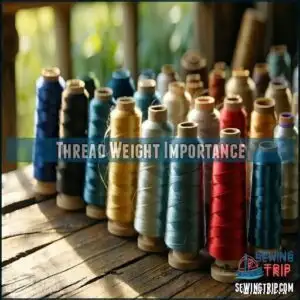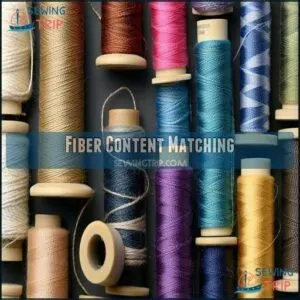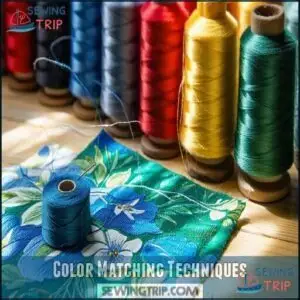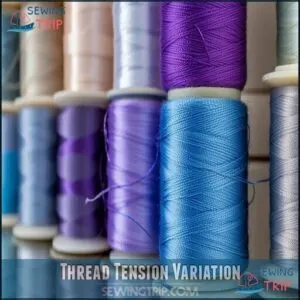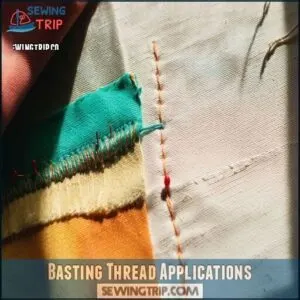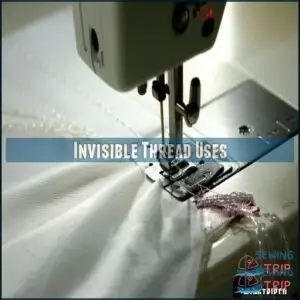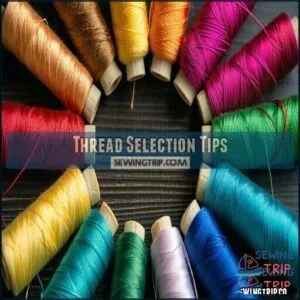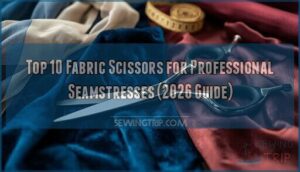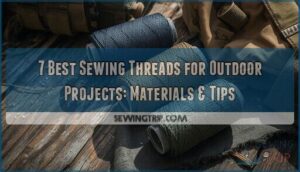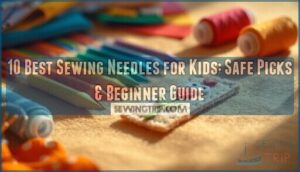This site is supported by our readers. We may earn a commission, at no cost to you, if you purchase through links.
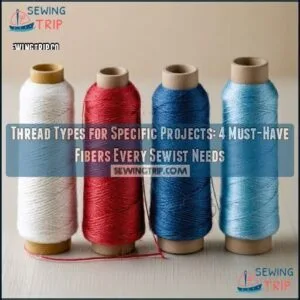
Cotton threads work best for quilting and natural fabrics, while polyester offers strength for everyday garments.
Silk threads create luxurious finishes on delicate fabrics, and rayon provides that high-sheen for decorative work.
Choose thread weight based on your fabric thickness—finer threads (50-60 weight) for lightweight materials, heavier threads (30-40 weight) for denim or canvas.
Always match thread fiber to your fabric when possible for ideal stretch, shrinkage, and care properties.
The right thread isn’t just a detail—it’s the backbone that holds your creative vision together.
Table Of Contents
Key Takeaways
- You’ll need to match your thread type to your fabric for best results—cotton for natural fabrics, polyester for synthetics, silk for delicate materials, and rayon for decorative work.
- Your thread weight matters—choose finer threads (50-60 weight) for lightweight fabrics and heavier threads (30-40 weight) for denim or canvas to ensure proper seam strength and appearance.
- You can prevent thread breakage by selecting quality thread, adjusting machine tension correctly, changing needles regularly, and matching thread type to your fabric’s stretch properties.
- You’ll get better results by considering specialty threads for specific projects—metallic threads for decorative stitching, invisible thread for hidden seams, basting thread for temporary stitching, and serger-specific threads for overlocking.
Thread Types Overview
You’ll need to match the right thread to your specific project, with options ranging from strong polyester for synthetics to soft cotton for natural fabrics.
Each thread type offers distinct properties that affect your final results, including strength, elasticity, sheen, and compatibility with different sewing techniques, which is crucial for achieving the desired outcome with elasticity being a key factor.
Cotton Thread Characteristics
Every sewist should understand cotton thread’s distinct characteristics. You’ll appreciate its natural properties that make it ideal for specific projects.
- Offers a matte finish with medium sheen that complements natural fabrics
- Features strength dependent on staple length – longer fibers create sturdier threads
- Withstands high iron temperatures without melting, perfect for cotton and linen fabrics
- Provides excellent dye retention while remaining biodegradable
For best results, match cotton thread with natural fabrics, but consider thread weight relative to the material.
Polyester Thread Features
With polyester thread, you’ll enjoy exceptional durability that withstands multiple washes without breaking.
It offers remarkable UV resistance and water repellency, making it perfect for outdoor and industrial applications.
The low stretch (about 26% elongation) provides just enough elasticity while maintaining thread strength for stress points.
Unlike natural fibers, these synthetic fibers resist heat damage and chemicals, ensuring your stitches stay intact through demanding conditions.
You can explore options for enhanced thread strength depending on your project.
Silk Thread Properties
While polyester threads offer synthetic durability, silk thread stands as nature’s engineering marvel.
This premium fiber delivers remarkable properties that make it indispensable for certain projects:
- Steel-like strength from aligned protein molecules
- Impressive elasticity with 15-35% stretch capacity
- Superior moisture absorption (up to 30% of its weight)
- Natural lustrous finish from triangular fiber structure
- Hypoallergenic and biodegradable composition
The 100wt silk thread’s exceptional seam strength makes it perfect for hand sewing delicate fabrics and tailoring applications.
Its strength impacts applications in unique ways, showcasing the natural lustrous finish and hypoallergenic nature of silk thread.
Rayon Thread Applications
The lustrous quality of rayon thread makes it a standout choice for machine embroidery projects.
You’ll appreciate its smooth run through high-speed sewing machines and exceptional color vibrancy.
Rayon’s natural wood pulp origin offers impressive durability for decorative stitching while maintaining a silk-like sheen.
It’s particularly suitable for formal apparel, home décor items, and accessories where that extra touch of elegance matters.
Choosing Right Thread
You’ll need to match your thread to both your fabric type and project requirements for ideal results.
Selecting the right weight, fiber content, and tension will prevent puckering and guarantee your seams maintain their strength through multiple washes.
Thread Weight Importance
Understanding thread weight can make or break your sewing project.
The lower the number, the thicker the thread—so a 30-weight is heavier than a 50-weight.
Thread thickness affects stitch visibility, project durability, and required tension adjustments.
You’ll need to match your thread weight selection to both fabric type and needle size.
Lightweight fabrics pair with finer threads, while heavier materials need sturdier options to ensure project durability.
Fiber Content Matching
Now that you know how thread weight affects your projects, let’s pair the right fibers together. Just as salt and pepper belong together, your thread and fabric need proper matching for ideal results.
- Your seams will thank you when natural threads meet natural fabrics
- Synthetic threads bond beautifully with man-made materials
- Project durability skyrockets with proper thread-fabric pairings
- Stitch quality improves when fibers complement each other
Always use identical thread types in both needle and bobbin for balanced tension. To achieve the best results, consider thread fiber content for fabric suitability.
Color Matching Techniques
The color-matching dance between thread and fabric can make or break your sewing project.
Always select thread colors in natural daylight to see true hues.
When working with patterned fabrics, match thread to the dominant color or choose a neutral shade.
| Technique | Best Practice |
|---|---|
| Daylight Matching | Check colors by window or daylight lamp |
| Fabric Undertones | Match to dominant undertone, not surface color |
| Shade Variation | Choose slightly darker thread for better blending |
| Lighting Influence | Test under various lights for consistency |
| Brand Consistency | Stick with one brand for reliable colorfastness |
Thread Tension Variation
Every thread type requires different tension settings on your machine.
Polyester threads need moderate tension, while silk demands lighter settings to prevent breaking.
Your bobbin tension should complement your upper thread weight for balanced stitches.
When you notice puckering or loops forming, adjust accordingly.
Fabric compatibility plays a vital role too—lightweight fabrics work best with reduced tension.
Regular tension troubleshooting guarantees consistent stitch quality across all your projects.
Top 4 Thread Types
You’ll need polyester, cotton, silk, and nylon threads in your sewing arsenal to tackle any project that comes your way.
These four essential thread types offer unique properties from strength and elasticity to shine and heat resistance, ensuring you’re prepared for everything from everyday garment repairs to specialized decorative work.
1. Madeira Cotona Cotton Embroidery Thread Set
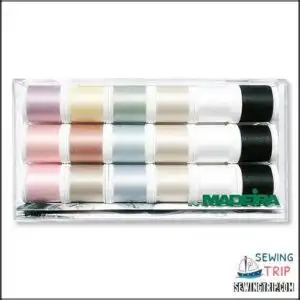
Why settle for less when Madeira Cotona offers supreme quality for your delicate projects?
This 100% Egyptian cotton thread set includes 18 spools with 200m each, perfect for embroidery, heirloom sewing, and fine seams.
The mercerized long-staple cotton delivers consistent tension and minimal lint, and you’ll appreciate its smooth finish and high tensile strength across all household machines.
Though priced higher at $58 per set, the thread’s durability and color consistency justify the investment, and the convenient storage box keeps your colors organized and protected for all your detailed machine quilting and appliqué work.
Best For: Sewing enthusiasts and professionals looking for high-quality thread for delicate fabrics, embroidery, and heirloom projects.
- Higher price at $58 per set compared to similar products.
- Thread strength may cause occasional breakage during use.
- Smaller spool size (200m) may not meet the needs of larger projects.
- Made from 100% mercerized long-staple Egyptian cotton for durability and minimal lint.
- Includes 18 spools with consistent color and smooth finish for flawless stitching.
- Convenient storage box keeps threads organized and protected.
2. Silver Wooly Nylon Serger Thread
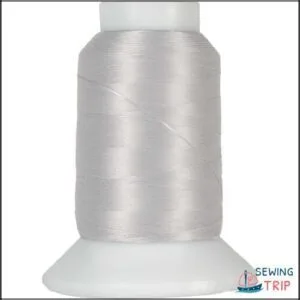
Flexibility defines Silver Wooly Nylon Serger Thread, making it an essential addition to your sewing arsenal.
This spun nylon fiber offers superior stretch compared to cotton or polyester threads, maintaining seam integrity even when stretched.
It’s ideal for both upper and lower loopers in your serger, creating professional-looking rolled hems and edges.
You’ll find it perfect for swimwear, lingerie, knits, and children’s clothing.
Each cone contains 3300 meters (3608 yards) of soft, washable thread.
It’s particularly effective for elastic seams in activewear and preventing edge raveling in stretch fabrics.
Best For: Professional sewers and hobbyists working with stretch fabrics like swimwear, lingerie, and activewear who need high durability and elasticity.
- Superior stretch and seam integrity for stretch fabrics.
- Offers professional rolled hems and edges.
- Large cone size (3300 meters) for multiple projects.
- Requires a serger for optimal performance.
- Fuzzy fibers may need a needle threader.
- Higher price compared to standard threads.
3. Embroidery Thread Organiser Spool Holder Rack

Organization meets functionality with this natural beechwood thread rack that holds up to 60 spools of various sizes.
You’ll appreciate the dual-purpose design—use it freestanding with foldable legs or mount it on your wall using the built-in hooks.
The 5.5mm thick spindle pegs keep your embroidery, sewing, and quilting threads neatly arranged by color, improving your workflow and saving time during projects.
Its unfinished surface allows for customization through painting or staining, while the compact dimensions (L40 x W17 x H32 cm) conserve valuable workspace in your sewing area, making it a great addition to your sewing space with its compact dimensions.
Best For: Sewing, embroidery, and quilting enthusiasts looking for a customizable, space-saving solution to organize up to 60 spools of thread.
- Stability issues may arise with freestanding use.
- Lightweight design feels sturdier when wall-mounted.
- Limited portability due to its size and lack of carrying handle.
- Holds up to 60 spools of various sizes and types.
- Dual-purpose design for freestanding or wall-mounted use.
- Unfinished wood allows for painting or staining customization.
4. Colonial Needle Long Darners Assorted Needles

These Finest Quality English Needles come in assorted sizes 3/9 with six needles per card.
Made from stainless and carbon steel, they’re always sharp and strong—perfect for heavy fabrics. The 4.5-inch length provides excellent control for various sewing projects.
Users praise their durability, noting they won’t bend or break easily during use. While some reviews mention discrepancies about manufacturing origin (imported by Entaco, assembled in England), their quality remains consistent.
These lightweight (0.32 ounces) needles feature clean eyes that prevent thread fraying, making them ideal for picture smocking and ribbon work.
Best For: Crafters and sewing enthusiasts working with heavy fabrics or intricate designs like picture smocking and ribbon work.
- Some discrepancies in manufacturing origin may cause confusion.
- Limited to 6 needles per pack.
- Not suitable if "Made in England" is a strict requirement.
- Strong and durable, won’t bend or break easily.
- Sharp and precise, ideal for heavy fabrics and intricate projects.
- Lightweight and easy to handle.
Specialty Thread Uses
You’ll need specialty threads when standard options won’t tackle unique sewing challenges or achieve specific decorative effects.
From invisible mending threads to shimmering metallics for embellishment, these purpose-specific fibers extend your creative possibilities while ensuring professional results on specialized projects.
Basting Thread Applications
After exploring those essential thread types, let’s look at a specialized option you’ll want in your toolkit.
Basting thread is designed specifically for temporary stitching when you’re fitting garments or stabilizing fabric layers.
This lightweight thread comes in contrasting colors so you can easily remove it after permanent stitching.
Use hand basting for precise control or machine basting (also called tacking) for quicker temporary seams.
Invisible Thread Uses
While basting thread serves temporary purposes, invisible thread tackles permanent yet hidden applications.
This clear nylon or polyester thread becomes your secret weapon for mending techniques and trims application where stitches shouldn’t show.
You’ll find it invaluable for seam concealment in costume design and when working with delicate fabrics. Choose between slightly shinier nylon or more heat-resistant polyester varieties based on your sewing projects and fabric matching needs.
Metallic Thread Decorative Stitching
While invisible thread disappears into your work, metallic thread does the opposite – it’s designed to shine.
Made by wrapping metallic fibers around a polyester, rayon, or nylon core, these specialty threads add sparkle to decorative stitching projects.
To prevent breakage, use a 90/14 needle, lower your tension, and apply thread conditioner. Many sewists find success when using quality metallic options.
Keep lengths short and consider using a thread stand for smoother fabric compatibility during embellishment work.
Machine Embroidery Thread High-gloss Finish
While metallic threads catch the eye, machine embroidery thread offers stunning high-gloss finish that transforms ordinary projects into showstoppers.
This specialty thread features exceptional thread lustre and color vibrancy that won’t fade with washing.
The material composition—typically rayon or polyester—ensures smooth high-speed sewing with minimal breakage.
Your embroidery machine will handle this embellishment thread effortlessly, creating precise stitch definition that makes your designs pop.
Polyester threads are known for superior color retention, making them ideal for projects requiring longevity.
Thread Selection Tips
You’ll need to match your thread’s fiber content to your fabric type for best results, ensuring polyester for synthetics and cotton for natural materials.
Consider the thread’s weight and strength based on your project requirements, with heavier threads for upholstery and lighter options for delicate fabrics, which is crucial for achieving the desired outcome with strength.
General Purpose Thread Selection
When choosing general purpose thread, match it to your fabric.
Cotton thread works best with natural fabrics, while polyester offers excellent color fastness for synthetics.
Consider thread weight for stitch visibility—thinner threads (higher numbers) create subtle seams, while thicker threads make statements.
Check brand reputation for quality assurance.
Remember, the right sewing thread enhances fabric compatibility and prevents puckering or breaking during your project.
Heavy-duty Thread Applications
When your project requires extra strength, you’ll need specialized thread that can handle the pressure.
Heavy-duty thread stands up to tough materials and high-stress applications.
For your demanding projects, consider:
- Upholstery thread with bonded polyester for furniture and cushions
- Heavy-duty nylon or polyester thread for leather projects and bags
- Extra-strong denim thread for jeans and workwear
Your sewing machine may need adjustments and a larger needle when working with industrial textiles or outdoor gear.
Some sewists prefer bonded nylon varieties for their 60-100lb strength.
Serger Thread Compatibility
Serger machines demand specific thread types for ideal performance. Your serger thread should match your tension adjustments needed—typically lighter and smoother than regular thread.
For looper thread usage, consider using the same thread in all positions or specialized cone threads that flow smoothly through the differential feed mechanisms.
When creating rolled hems, choose finer threads that won’t bulk up edges or compromise your machine’s needle compatibility.
Environmental Thread Considerations
While serger projects require specific thread types, your environmental impact matters too.
Proper thread storage maintains quality but also reduces waste.
Opt for environmentally responsible threads when possible.
- Store threads in dust-free containers to extend their usable life
- Consider recycled thread options like Gütermann’s Sew-all made from plastic bottles
- Look for organic cotton threads like Scanfil, which come on wooden spools instead of plastic, to further minimize your waste.
Frequently Asked Questions (FAQs)
Can thread expire or go bad?
Yes, thread doesn’t technically expire but deteriorates over time.
You’ll notice discoloration, brittleness, and breakage when improperly stored.
Test old thread by tying a knot and pulling gently—if it breaks, it’s time for replacement.
How to prevent thread breakage?
Like a temperamental artist, thread needs proper handling.
Use quality thread, adjust tension correctly, change needles regularly, and clean your machine.
Match thread type to fabric, and don’t sew too fast to prevent breakage.
Best thread for elastic fabrics?
Polyester-wrapped core thread offers ideal stretch and recovery for elastic fabrics.
You’ll want this blend for swimwear, activewear, and stretchy garments.
It moves with the fabric without breaking or causing puckering.
Thread alternatives for allergic individuals?
Cutting through the fabric of discomfort, you can use synthetic polyester threads that undergo hypoallergenic treatment.
Bamboo-based threads, organic cotton, or TENCEL™ lyocell threads that avoid common allergens causing skin reactions, are also viable options to consider for reducing discomfort.
Thread storage for humidity control?
Store your threads in airtight containers with silica gel packets.
You’ll extend their lifespan by keeping them away from bathrooms or basements.
Consider thread boxes with rubber seals for maximum humidity protection.
Conclusion
After exploring these fiber options, you’ll now recognize that selecting thread types for specific projects isn’t merely technical—it’s an art form.
Whether you’re quilting with cotton, reinforcing garments with polyester, embellishing with silk, or decorating with rayon, you’ve got the knowledge to make informed choices.
Remember that matching thread weight and fiber content to your fabric guarantees durability and professional results.
Your sewing toolkit isn’t complete without these four essential thread types for specific projects.


